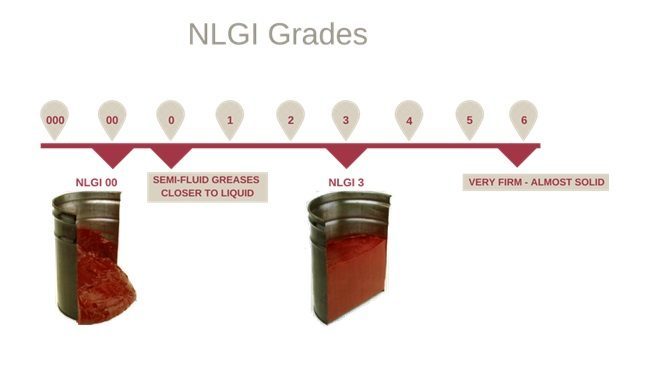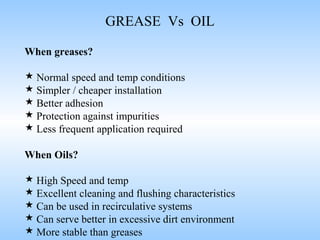Explain Difference Between Grease and Oil Used as Lubricants
It wont last long. It has semi-fluid or solid structure as opposed to the syrup-like consistency of oil.

Oil Vs Grease What S The Difference The Lubricant Store
All lubricants start with a base oil.

. Graphite molybdenum disulfide Polytetrafluoroethylene are some lubricating particles present in grease. There are several types of lubricants for different applications. The surfaces are exposed to water or anything that can wash the oil away.
A lubricant is an organic substance used to reduce friction between two surfaces that are in contact with each other. Up to 30 of grease is made up of thickener a simple or complex soap. Below is a useful table explaining NLGI numbers Reference.
Grease is a solid or semisolid lubricant formed as a dispersion of thickening agents in a liquid lubricant. Lubricants prevent the engine to get corrosion and reduce the friction between two surfaces. This occurs when oil transfers heat into a larger body of oil allowing it to then be pumped through a heat exchanger.
All oils can be turned into greases but not all greases come from oils. Gun oilslubricants tend to be less viscous while grease has a. It is done by ultimately reducing friction and the heat generated when the two surfaces move.
Grease shares the same additives as oil however it needs protection from its dropping point the upper temperature at which the grease retains its structure after which it loses its plasticity and starts behaving more like an oil. The difference in viscosity at different temperatures is the viscosity index VI. A common feature of greases is that they possess a high initial viscosity which upon the application of shear drops to give the effect of an oil-lubricated bearing of approximately the same viscosity as the.
Grease generally consists of a soap emulsified with mineral or vegetable oil. At room temperature greases are usually solid while oils are usually liquid. If you put a liquid like oil between two solid gears it will shift about and change its shape as much as it needs to cushioning the microscopic bumps between the gears as they mesh together and reducing the friction between them.
Greases are usually oils with thickener added. 70 to 95 base oil mineral synthetic or vegetable 0 to 10 additive as previously mentioned. Grease is typically only used on machinery tools or equipment whereas oils have a wide range of non-industrial applications.
The NLGI is a not-for-profit trade association that as part of its remit it publishes industry standards for greases. Based on the cooling properties of oil when the application at hand generates a lot of heat it is better to use oil as both a. This thickness is crucial to the separation of the rolling and sliding elements in a bearing.
It adheres to the surface. 3 to 20 thickening or gelling agent which increases the viscosity of the lubricant semi-fluid fluid soft or hard and to trap base oil and additives and to avoid leaking. Synthetics Mineral Oils and Bio-Based Lubricants.
The process of reducing friction is most commonly known as lubricity. The application determines which oil commonly referred to as the base oil should be used. However there is some difference between them.
While oil can help make things water resistant it can also absorb water over time. Greases are typically only used on machinery tools or equipment while oils have many other non-industrial uses. In order for the grease to be effective some oil must be separated.
Grease remains solid at room temperature while oil remains in liquid state. The more water that absorbs into the oil the lower its adhesion will be causing it to wash off of the very parts that need lubrication Greases. Its all about that base.
Grease provides an excellent seal to the components to keep them moving for long-lasting. Generally mineral oils are used for making grease and thickeners like lithium base soaps are here with grease. During the combustion petrol vapour may accept past the piston ring if the rings are worn or broken.
Ingredients andor compounds must comply with 21 CFR parts 182 and 184. 10th November 2020. The food-grade lubricants must comply with the requirements of the draft standard as well as CFR Title 21 1783570 and more specifically sections 172860 for vegetable oils and 172878 for mineral oils.
Lubricating properties of the oil are present in grease with stickiness. The main difference between them is their viscosity. A heavier and high viscosity base oil is used to.
Grease is composed of oil and a thickening agent to obtain its consistency while the oil is what actually lubricates. Bearings in some applications use oil but grease is the lubricant of choice for 80 to 90 of bearings. In extreme conditions synthetic oils can be beneficial.
Evaluation requires that the manufacturer or supplier disclose the. Oils can be synthetic vegetable or mineral-based as well as a combination of these. An oils viscosity is correlative to the film thickness it can create.
These standard classifications are widely used. A low viscosity and light base oil is used to produce grease that works at low temperatures. Chemistry and Technology Chemical.
When To Use Each. Lyden Oil Company - Youngstown 3711 LeHarps Drive Youngstown OH 44515 Phone 1 800 362-9410 Fax. The only difference between fluids and grease is that the latter has an extra thickener.
Lubricating grease is oil with thickener added. Whereas oil helps in high speed and maintaining the temperature of the vehicle. Lubricates such as oil and grease provides different benefits.
Typically the ratio is somewhere around 90 base oil 10 additives. Colours of lubricating oil are not of so much importance for its properties aspect as a test for checking the uniformity of any given grade or brand of oil. All oils can be converted into greases but not all greases are derived from oils.
A basic property of oils is cooling. For any given lubricating oil the simple recipe is a base oil additives. Think of the difference between ice which just sits there in a lump and water which flows easily as you pour it.
Grease is usually solid at room temperature whereas oil is usually liquid. Grease is typically an oil with a thickener added. Experts will often use the terms oil and lubricant interchangeably whereas grease is a completely different solution.

Mechanical Engineering Lubrication Chemical Structure Lubricants Physical Properties

Interflon What Is The Difference Between Oil And Grease

What Are The Main Differences Between Grease And Oil Youtube

Belum ada Komentar untuk "Explain Difference Between Grease and Oil Used as Lubricants"
Posting Komentar